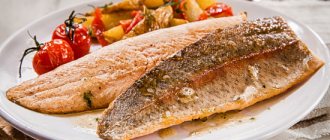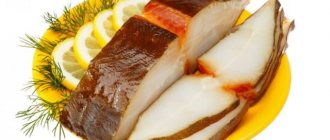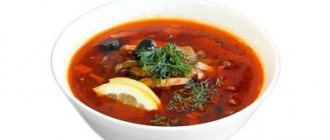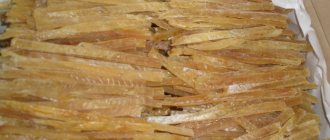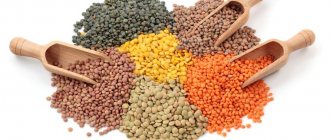Calorie content of baked carp. Chemical composition and nutritional value.
Nutritional value and chemical composition of “baked carp”.
The table shows the nutritional content (calories, proteins, fats, carbohydrates, vitamins and minerals) per 100 grams of edible portion.
| Nutrient | Quantity | Norm** | % of the norm in 100 g | % of the norm in 100 kcal | 100% normal |
| Calorie content | 162 kcal | 1684 kcal | 9.6% | 5.9% | 1040 g |
| Squirrels | 22.86 g | 76 g | 30.1% | 18.6% | 332 g |
| Fats | 7.17 g | 56 g | 12.8% | 7.9% | 781 g |
| Water | 69.63 g | 2273 g | 3.1% | 1.9% | 3264 g |
| Vitamins | |||||
| Vitamin A, RE | 10 mcg | 900 mcg | 1.1% | 0.7% | 9000 g |
| Vitamin B1, thiamine | 0.14 mg | 1.5 mg | 9.3% | 5.7% | 1071 g |
| Vitamin B2, riboflavin | 0.07 mg | 1.8 mg | 3.9% | 2.4% | 2571 g |
| Vitamin B5, pantothenic | 0.87 mg | 5 mg | 17.4% | 10.7% | 575 g |
| Vitamin B6, pyridoxine | 0.219 mg | 2 mg | 11% | 6.8% | 913 g |
| Vitamin B9, folates | 17 mcg | 400 mcg | 4.3% | 2.7% | 2353 g |
| Vitamin C, ascorbic acid | 1.6 mg | 90 mg | 1.8% | 1.1% | 5625 g |
| Vitamin RR, NE | 2.1 mg | 20 mg | 10.5% | 6.5% | 952 g |
| Macronutrients | |||||
| Potassium, K | 427 mg | 2500 mg | 17.1% | 10.6% | 585 g |
| Calcium, Ca | 52 mg | 1000 mg | 5.2% | 3.2% | 1923 |
| Magnesium, Mg | 38 mg | 400 mg | 9.5% | 5.9% | 1053 g |
| Sodium, Na | 63 mg | 1300 mg | 4.8% | 3% | 2063 g |
| Phosphorus, P | 531 mg | 800 mg | 66.4% | 41% | 151 g |
| Microelements | |||||
| Iron, Fe | 1.59 mg | 18 mg | 8.8% | 5.4% | 1132 g |
| Manganese, Mn | 0.005 mg | 2 mg | 0.3% | 0.2% | 40000 g |
| Copper, Cu | 0.073 mcg | 1000 mcg | 1369863 g | ||
| Selenium, Se | 16.2 mcg | 55 mcg | 29.5% | 18.2% | 340 g |
| Zinc, Zn | 1.9 mg | 12 mg | 15.8% | 9.8% | 632 g |
| Sterols (sterols) | |||||
| Cholesterol | 84 mg | max 300 mg |
The energy value of baked carp is 162 kcal.
Primary Source: Created in the application by the user. Read more.
** This table shows the average levels of vitamins and minerals for an adult. If you want to know the norms taking into account your gender, age and other factors, then use the “My Healthy Diet” application.
Source
Calorie content Carp baked in the oven. Chemical composition and nutritional value.
Nutritional value and chemical composition of “Carp baked in the oven.”
The table shows the nutritional content (calories, proteins, fats, carbohydrates, vitamins and minerals) per 100 grams of edible portion.
| Nutrient | Quantity | Norm** | % of the norm in 100 g | % of the norm in 100 kcal | 100% normal |
| Calorie content | 128.5 kcal | 1684 kcal | 7.6% | 5.9% | 1311 g |
| Squirrels | 14.5 g | 76 g | 19.1% | 14.9% | 524 g |
| Fats | 7.7 g | 56 g | 13.8% | 10.7% | 727 g |
| Carbohydrates | 0.5 g | 219 g | 0.2% | 0.2% | 43800 g |
| Water | 77.4 g | 2273 g | 3.4% | 2.6% | 2937 g |
| Ash | 1.3 g | ~ | |||
| Vitamins | |||||
| Vitamin A, RE | 20 mcg | 900 mcg | 2.2% | 1.7% | 4500 g |
| Retinol | 0.02 mg | ~ | |||
| Vitamin B1, thiamine | 0.14 mg | 1.5 mg | 9.3% | 7.2% | 1071 g |
| Vitamin B2, riboflavin | 0.055 mg | 1.8 mg | 3.1% | 2.4% | 3273 g |
| Vitamin B4, choline | 65 mg | 500 mg | 13% | 10.1% | 769 g |
| Vitamin B5, pantothenic | 0.2 mg | 5 mg | 4% | 3.1% | 2500 g |
| Vitamin B6, pyridoxine | 0.17 mg | 2 mg | 8.5% | 6.6% | 1176 g |
| Vitamin B9, folates | 9.3 mcg | 400 mcg | 2.3% | 1.8% | 4301 g |
| Vitamin B12, cobalamin | 1.5 mcg | 3 mcg | 50% | 38.9% | 200 g |
| Vitamin C, ascorbic acid | 1.5 mg | 90 mg | 1.7% | 1.3% | 6000 g |
| Vitamin D, calciferol | 24.7 mcg | 10 mcg | 247% | 192.2% | 40 g |
| Vitamin E, alpha tocopherol, TE | 0.5 mg | 15 mg | 3.3% | 2.6% | 3000 g |
| Vitamin K, phylloquinone | 0.1 mcg | 120 mcg | 0.1% | 0.1% | 120000 g |
| Vitamin RR, NE | 5.5 mg | 20 mg | 27.5% | 21.4% | 364 g |
| Niacin | 2.5 mg | ~ | |||
| Macronutrients | |||||
| Potassium, K | 265 mg | 2500 mg | 10.6% | 8.2% | 943 g |
| Calcium, Ca | 35 mg | 1000 mg | 3.5% | 2.7% | 2857 g |
| Magnesium, Mg | 25 mg | 400 mg | 6.3% | 4.9% | 1600 g |
| Sodium, Na | 55 mg | 1300 mg | 4.2% | 3.3% | 2364 g |
| Sera, S | 180 mg | 1000 mg | 18% | 14% | 556 g |
| Phosphorus, P | 210 mg | 800 mg | 26.3% | 20.5% | 381 g |
| Chlorine, Cl | 55 mg | 2300 mg | 2.4% | 1.9% | 4182 g |
| Microelements | |||||
| Iron, Fe | 0.8 mg | 18 mg | 4.4% | 3.4% | 2250 g |
| Yod, I | 5 mcg | 150 mcg | 3.3% | 2.6% | 3000 g |
| Cobalt, Co | 35 mcg | 10 mcg | 350% | 272.4% | 29 g |
| Manganese, Mn | 0.15 mg | 2 mg | 7.5% | 5.8% | 1333 g |
| Copper, Cu | 130 mcg | 1000 mcg | 13% | 10.1% | 769 g |
| Molybdenum, Mo | 4 mcg | 70 mcg | 5.7% | 4.4% | 1750 g |
| Nickel, Ni | 7 mcg | ~ | |||
| Selenium, Se | 12.6 mcg | 55 mcg | 22.9% | 17.8% | 437 g |
| Fluorine, F | 25 mcg | 4000 mcg | 0.6% | 0.5% | 16000 g |
| Chromium, Cr | 55 mcg | 50 mcg | 110% | 85.6% | 91 g |
| Zinc, Zn | 2.08 mg | 12 mg | 17.3% | 13.5% | 577 g |
| Essential amino acids | |||||
| Arginine* | 0.9 g | ~ | |||
| Valin | 1.1 g | ~ | |||
| Histidine* | 0.3 g | ~ | |||
| Isoleucine | 0.8 g | ~ | |||
| Leucine | 1.8 g | ~ | |||
| Lysine | 1.9 g | ~ | |||
| Methionine | 0.5 g | ~ | |||
| Methionine + Cysteine | 0.65 g | ~ | |||
| Threonine | 0.9 g | ~ | |||
| Tryptophan | 0.18 g | ~ | |||
| Phenylalanine | 0.8 g | ~ | |||
| Phenylalanine+Tyrosine | 1.3 g | ~ | |||
| Nonessential amino acids | |||||
| Alanin | 1 g | ~ | |||
| Aspartic acid | 1.7 g | ~ | |||
| Glycine | 0.6 g | ~ | |||
| Glutamic acid | 2.7 g | ~ | |||
| Proline | 0.5 g | ~ | |||
| Serin | 0.8 g | ~ | |||
| Tyrosine | 0.5 g | ~ | |||
| Cysteine | 0.15 g | ~ | |||
| Sterols (sterols) | |||||
| Cholesterol | 55 mg | max 300 mg | |||
| Saturated fatty acids | |||||
| Saturated fatty acids | 1.2 g | max 18.7 g | |||
| 14:0 Miristinovaya | 0.04 g | ~ | |||
| 16:0 Palmitinaya | 0.78 g | ~ | |||
| 17:0 Margarine | 0.01 g | ~ | |||
| 18:0 Stearic | 0.32 g | ~ | |||
| 22:0 Begenovaya | 0.01 g | ~ | |||
| Monounsaturated fatty acids | 2.57 g | min 16.8 g | 15.3% | 11.9% | |
| 16:1 Palmitoleic | 0.38 g | ~ | |||
| 18:1 Oleic (omega-9) | 2.08 g | ~ | |||
| 20:1 Gadoleic (omega-9) | 0.1 g | ~ | |||
| 22:1 Erucic (omega-9) | 0.01 g | ~ | |||
| Polyunsaturated fatty acids | 0.36 g | from 11.2 to 20.6 g | 3.2% | 2.5% | |
| 18:2 Linolevaya | 0.27 g | ~ | |||
| 18:3 Linolenic | 0.03 g | ~ | |||
| 18:4 Steoride Omega-3 | 0.01 g | ~ | |||
| 20:4 Arachidonic | 0.02 g | ~ | |||
| 20:5 Eicosapentaenoic acid (EPA), Omega-3 | 0.305 g | ~ | |||
| Omega-3 fatty acids | 0.06 g | from 0.9 to 3.7 g | 6.7% | 5.2% | |
| 22:5 Docosapentaenoic acid (DPA), Omega-3 | 0.01 g | ~ | |||
| 22:6 Docosahexaenoic acid (DHA), Omega-3 | 0.02 g | ~ | |||
| Omega-6 fatty acids | 0.29 g | from 4.7 to 16.8 g | 6.2% | 4.8% |
The energy value of carp baked in the oven is 128.5 kcal.
Primary Source: Created in the application by the user. Read more.
** This table shows the average levels of vitamins and minerals for an adult. If you want to know the norms taking into account your gender, age and other factors, then use the “My Healthy Diet” application.
Recipe Carp baked in the oven. Calorie, chemical composition and nutritional value.
Carp baked in the oven is rich in vitamins and minerals such as: vitamin B1 - 12.5%, choline - 17.5%, vitamin B6 - 11.5%, vitamin B12 - 67.3%, vitamin D - 332.3% , vitamin PP - 37%, potassium - 14.3%, phosphorus - 35.3%, cobalt - 470.8%, copper - 17.5%, selenium - 30.8%, chromium - 148%, zinc - 23 .3%
- Vitamin B1 is part of the most important enzymes of carbohydrate and energy metabolism, providing the body with energy and plastic substances, as well as the metabolism of branched amino acids. A lack of this vitamin leads to serious disorders of the nervous, digestive and cardiovascular systems.
- Choline is part of lecithin, plays a role in the synthesis and metabolism of phospholipids in the liver, is a source of free methyl groups, and acts as a lipotropic factor.
- Vitamin B6 is involved in maintaining the immune response, processes of inhibition and excitation in the central nervous system, in the transformation of amino acids, the metabolism of tryptophan, lipids and nucleic acids, promotes the normal formation of red blood cells, and maintaining normal levels of homocysteine in the blood. Insufficient intake of vitamin B6 is accompanied by decreased appetite, impaired skin condition, and the development of homocysteinemia and anemia.
- Vitamin B12 plays an important role in the metabolism and transformation of amino acids. Folate and vitamin B12 are interconnected vitamins that are involved in hematopoiesis. A lack of vitamin B12 leads to the development of partial or secondary folate deficiency, as well as anemia, leukopenia, and thrombocytopenia.
- Vitamin D maintains calcium and phosphorus homeostasis and carries out the processes of bone tissue mineralization. A lack of vitamin D leads to impaired metabolism of calcium and phosphorus in the bones, increased demineralization of bone tissue, which leads to an increased risk of developing osteoporosis.
- Vitamin PP is involved in redox reactions of energy metabolism. Insufficient vitamin intake is accompanied by disruption of the normal condition of the skin, gastrointestinal tract and nervous system.
- Potassium is the main intracellular ion that takes part in the regulation of water, acid and electrolyte balance, and is involved in the processes of conducting nerve impulses and regulating blood pressure.
- Phosphorus takes part in many physiological processes, including energy metabolism, regulates acid-base balance, is part of phospholipids, nucleotides and nucleic acids, and is necessary for the mineralization of bones and teeth. Deficiency leads to anorexia, anemia, and rickets.
- Cobalt is part of vitamin B12. Activates enzymes of fatty acid metabolism and folic acid metabolism.
- Copper is part of enzymes that have redox activity and are involved in the metabolism of iron, stimulates the absorption of proteins and carbohydrates. Participates in the processes of providing oxygen to the tissues of the human body. Deficiency is manifested by disturbances in the formation of the cardiovascular system and skeleton, and the development of connective tissue dysplasia.
- Selenium is an essential element of the antioxidant defense system of the human body, has an immunomodulatory effect, and is involved in the regulation of the action of thyroid hormones. Deficiency leads to Kashin-Beck disease (osteoarthritis with multiple deformities of the joints, spine and limbs), Keshan disease (endemic myocardiopathy), and hereditary thrombasthenia.
- Chromium is involved in the regulation of blood glucose levels, enhancing the effect of insulin. Deficiency leads to decreased glucose tolerance.
- Zinc is part of more than 300 enzymes and is involved in the processes of synthesis and breakdown of carbohydrates, proteins, fats, nucleic acids and in the regulation of the expression of a number of genes. Insufficient consumption leads to anemia, secondary immunodeficiency, liver cirrhosis, sexual dysfunction, and the presence of fetal malformations. Research in recent years has revealed the ability of high doses of zinc to disrupt the absorption of copper and thereby contribute to the development of anemia.
Baked carp recipe. Calorie, chemical composition and nutritional value.
Baked carp is rich in vitamins and minerals such as: choline - 14.8%, vitamin B12 - 58.7%, vitamin D - 280.3%, vitamin PP - 30.2%, potassium - 12%, phosphorus - 32, 6%, chlorine - 49.8%, cobalt - 408.8%, copper - 16%, selenium - 20.7%, chromium - 127.6%, zinc - 20.8%
- Choline is part of lecithin, plays a role in the synthesis and metabolism of phospholipids in the liver, is a source of free methyl groups, and acts as a lipotropic factor.
- Vitamin B12 plays an important role in the metabolism and transformation of amino acids. Folate and vitamin B12 are interconnected vitamins that are involved in hematopoiesis. A lack of vitamin B12 leads to the development of partial or secondary folate deficiency, as well as anemia, leukopenia, and thrombocytopenia.
- Vitamin D maintains calcium and phosphorus homeostasis and carries out the processes of bone tissue mineralization. A lack of vitamin D leads to impaired metabolism of calcium and phosphorus in the bones, increased demineralization of bone tissue, which leads to an increased risk of developing osteoporosis.
- Vitamin PP is involved in redox reactions of energy metabolism. Insufficient vitamin intake is accompanied by disruption of the normal condition of the skin, gastrointestinal tract and nervous system.
- Potassium is the main intracellular ion that takes part in the regulation of water, acid and electrolyte balance, and is involved in the processes of conducting nerve impulses and regulating blood pressure.
- Phosphorus takes part in many physiological processes, including energy metabolism, regulates acid-base balance, is part of phospholipids, nucleotides and nucleic acids, and is necessary for the mineralization of bones and teeth. Deficiency leads to anorexia, anemia, and rickets.
- Chlorine is necessary for the formation and secretion of hydrochloric acid in the body.
- Cobalt is part of vitamin B12. Activates enzymes of fatty acid metabolism and folic acid metabolism.
- Copper is part of enzymes that have redox activity and are involved in the metabolism of iron, stimulates the absorption of proteins and carbohydrates. Participates in the processes of providing oxygen to the tissues of the human body. Deficiency is manifested by disturbances in the formation of the cardiovascular system and skeleton, and the development of connective tissue dysplasia.
- Selenium is an essential element of the antioxidant defense system of the human body, has an immunomodulatory effect, and is involved in the regulation of the action of thyroid hormones. Deficiency leads to Kashin-Beck disease (osteoarthritis with multiple deformities of the joints, spine and limbs), Keshan disease (endemic myocardiopathy), and hereditary thrombasthenia.
- Chromium is involved in the regulation of blood glucose levels, enhancing the effect of insulin. Deficiency leads to decreased glucose tolerance.
- Zinc is part of more than 300 enzymes and is involved in the processes of synthesis and breakdown of carbohydrates, proteins, fats, nucleic acids and in the regulation of the expression of a number of genes. Insufficient consumption leads to anemia, secondary immunodeficiency, liver cirrhosis, sexual dysfunction, and the presence of fetal malformations. Research in recent years has revealed the ability of high doses of zinc to disrupt the absorption of copper and thereby contribute to the development of anemia.
Recipe Baked carp. Calorie, chemical composition and nutritional value.
Baked carp is rich in vitamins and minerals such as: choline - 13.5%, vitamin B12 - 58%, vitamin D - 234.9%, vitamin E - 14.4%, vitamin PP - 25.7%, potassium - 11 .2%, phosphorus - 32.9%, cobalt - 341.9%, copper - 13.8%, selenium - 20.8%, chromium - 108.1%, zinc - 20.3%
- Choline is part of lecithin, plays a role in the synthesis and metabolism of phospholipids in the liver, is a source of free methyl groups, and acts as a lipotropic factor.
- Vitamin B12 plays an important role in the metabolism and transformation of amino acids. Folate and vitamin B12 are interconnected vitamins that are involved in hematopoiesis. A lack of vitamin B12 leads to the development of partial or secondary folate deficiency, as well as anemia, leukopenia, and thrombocytopenia.
- Vitamin D maintains calcium and phosphorus homeostasis and carries out the processes of bone tissue mineralization. A lack of vitamin D leads to impaired metabolism of calcium and phosphorus in the bones, increased demineralization of bone tissue, which leads to an increased risk of developing osteoporosis.
- Vitamin E has antioxidant properties, is necessary for the functioning of the gonads and heart muscle, and is a universal stabilizer of cell membranes. With vitamin E deficiency, hemolysis of erythrocytes and neurological disorders are observed.
- Vitamin PP is involved in redox reactions of energy metabolism. Insufficient vitamin intake is accompanied by disruption of the normal condition of the skin, gastrointestinal tract and nervous system.
- Potassium is the main intracellular ion that takes part in the regulation of water, acid and electrolyte balance, and is involved in the processes of conducting nerve impulses and regulating blood pressure.
- Phosphorus takes part in many physiological processes, including energy metabolism, regulates acid-base balance, is part of phospholipids, nucleotides and nucleic acids, and is necessary for the mineralization of bones and teeth. Deficiency leads to anorexia, anemia, and rickets.
- Cobalt is part of vitamin B12. Activates enzymes of fatty acid metabolism and folic acid metabolism.
- Copper is part of enzymes that have redox activity and are involved in the metabolism of iron, stimulates the absorption of proteins and carbohydrates. Participates in the processes of providing oxygen to the tissues of the human body. Deficiency is manifested by disturbances in the formation of the cardiovascular system and skeleton, and the development of connective tissue dysplasia.
- Selenium is an essential element of the antioxidant defense system of the human body, has an immunomodulatory effect, and is involved in the regulation of the action of thyroid hormones. Deficiency leads to Kashin-Beck disease (osteoarthritis with multiple deformities of the joints, spine and limbs), Keshan disease (endemic myocardiopathy), and hereditary thrombasthenia.
- Chromium is involved in the regulation of blood glucose levels, enhancing the effect of insulin. Deficiency leads to decreased glucose tolerance.
- Zinc is part of more than 300 enzymes and is involved in the processes of synthesis and breakdown of carbohydrates, proteins, fats, nucleic acids and in the regulation of the expression of a number of genes. Insufficient consumption leads to anemia, secondary immunodeficiency, liver cirrhosis, sexual dysfunction, and the presence of fetal malformations. Research in recent years has revealed the ability of high doses of zinc to disrupt the absorption of copper and thereby contribute to the development of anemia.
How to choose fresh carp
Thanks to the active growth and reproduction of carp dishes, they have become a kind of universal menu solution. However, regardless of the method of heat treatment, it is important to pay attention to the original, fresh state of the fish.
The golden rules for purchasing and selecting fresh carp are presented in the following points:
- Checking the gills is the first step of the “audit”. Pay attention to their color: it should be as far away from red-pink shades as possible. Clumped gills of an unnatural shape are a signal of depravity.
- Water in the transparent convex eyes of fresh carp indicates a good quality product.
- The integument must be intact, the scales must be moist, covered with transparent and slippery mucus.
- The elasticity of the fish gives the go-ahead for purchase.
- The pleasant smell of a product is not always a guarantee of its freshness (thanks to flavoring agents). If there is a suspicious smell, refuse to purchase.
- The abundance of blood on the fish’s body is an indicator of illness. The acceptable healthy number of blood spots is 2-3.
Baked carp recipe. Calorie, chemical composition and nutritional value.
Baked carp is rich in vitamins and minerals such as: choline - 12.7%, vitamin B12 - 50%, vitamin D - 238.9%, vitamin PP - 26%, potassium - 13.1%, phosphorus - 28.8% , cobalt - 346.2%, manganese - 42.1%, copper - 20.5%, selenium - 18.2%, chromium - 108.8%, zinc - 18.2%
- Choline is part of lecithin, plays a role in the synthesis and metabolism of phospholipids in the liver, is a source of free methyl groups, and acts as a lipotropic factor.
- Vitamin B12 plays an important role in the metabolism and transformation of amino acids. Folate and vitamin B12 are interconnected vitamins that are involved in hematopoiesis. A lack of vitamin B12 leads to the development of partial or secondary folate deficiency, as well as anemia, leukopenia, and thrombocytopenia.
- Vitamin D maintains calcium and phosphorus homeostasis and carries out the processes of bone tissue mineralization. A lack of vitamin D leads to impaired metabolism of calcium and phosphorus in the bones, increased demineralization of bone tissue, which leads to an increased risk of developing osteoporosis.
- Vitamin PP is involved in redox reactions of energy metabolism. Insufficient vitamin intake is accompanied by disruption of the normal condition of the skin, gastrointestinal tract and nervous system.
- Potassium is the main intracellular ion that takes part in the regulation of water, acid and electrolyte balance, and is involved in the processes of conducting nerve impulses and regulating blood pressure.
- Phosphorus takes part in many physiological processes, including energy metabolism, regulates acid-base balance, is part of phospholipids, nucleotides and nucleic acids, and is necessary for the mineralization of bones and teeth. Deficiency leads to anorexia, anemia, and rickets.
- Cobalt is part of vitamin B12. Activates enzymes of fatty acid metabolism and folic acid metabolism.
- Manganese is involved in the formation of bone and connective tissue, and is part of enzymes involved in the metabolism of amino acids, carbohydrates, and catecholamines; necessary for the synthesis of cholesterol and nucleotides. Insufficient consumption is accompanied by slower growth, disturbances in the reproductive system, increased fragility of bone tissue, and disturbances in carbohydrate and lipid metabolism.
- Copper is part of enzymes that have redox activity and are involved in the metabolism of iron, stimulates the absorption of proteins and carbohydrates. Participates in the processes of providing oxygen to the tissues of the human body. Deficiency is manifested by disturbances in the formation of the cardiovascular system and skeleton, and the development of connective tissue dysplasia.
- Selenium is an essential element of the antioxidant defense system of the human body, has an immunomodulatory effect, and is involved in the regulation of the action of thyroid hormones. Deficiency leads to Kashin-Beck disease (osteoarthritis with multiple deformities of the joints, spine and limbs), Keshan disease (endemic myocardiopathy), and hereditary thrombasthenia.
- Chromium is involved in the regulation of blood glucose levels, enhancing the effect of insulin. Deficiency leads to decreased glucose tolerance.
- Zinc is part of more than 300 enzymes and is involved in the processes of synthesis and breakdown of carbohydrates, proteins, fats, nucleic acids and in the regulation of the expression of a number of genes. Insufficient consumption leads to anemia, secondary immunodeficiency, liver cirrhosis, sexual dysfunction, and the presence of fetal malformations. Research in recent years has revealed the ability of high doses of zinc to disrupt the absorption of copper and thereby contribute to the development of anemia.
You can see a complete guide to the healthiest foods in the “My Healthy Diet” app.
Source
Calorie content of carp
An important aspect in cooking carp is the calorie content of the main product. It is recommended not only for dieters, but also for adherents of a healthy lifestyle to take into account the energy value of foods.
| Type of processing | Calorie content | Weight |
| Fresh | 112 kcal | 100 grams of product |
| Fried | 196 kcal | |
| Boiled | 102 kcal | |
| Baked | 124 kcal |

